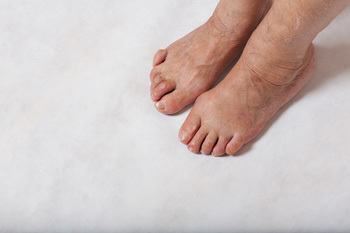Hammertoes are a common deformity in which the second, third, fourth, or fifth toes bend downward at the middle joint. This gives the affected toes a hammer-like appearance. They may also be referred to as claw toes, mallet toes, or retracted toes. This deformity is said to be more common among people who have bunions or high arches. Wearing poorly-fitted shoes and socks that squish the toes together can exacerbate the problem as well. Hammertoes can be stiff and painful. Over time, the toe joints can lose their flexibility and you may be unable to straighten the toes without surgical intervention. People with hammertoes also often notice corns and calluses forming at the tops of their toes, where the skin over the bent toes rubs against shoes. If you are suffering from hammertoes it is suggested that you seek the care of a podiatrist.
Hammertoe
Hammertoes can be a painful condition to live with. For more information, contact one of the chiropodists from The Footcare Centre. Our chiropodists will answer any of your foot- and ankle-related questions.
Hammertoe is a foot deformity that affects the joints of the second, third, fourth, or fifth toes of your feet. It is a painful foot condition in which these toes curl and arch up, which can often lead to pain when wearing footwear.
Symptoms
- Pain in the affected toes
- Development of corns or calluses due to friction
- Inflammation
- Redness
- Contracture of the toes
Causes
Genetics – People who are genetically predisposed to hammertoe are often more susceptible
Arthritis – Because arthritis affects the joints in your toes, further deformities stemming from arthritis can occur
Trauma – Direct trauma to the toes could potentially lead to hammertoe
Ill-fitting shoes – Undue pressure on the front of the toes from ill-fitting shoes can potentially lead to the development of hammertoe
Treatment
Orthotics – Custom made inserts can be used to help relieve pressure placed on the toes and therefore relieve some of the pain associated with it
Medications – Oral medications such as anti-inflammatories or NSAIDs could be used to treat the pain and inflammation hammertoes causes. Injections of corticosteroids are also sometimes used
Surgery – In more severe cases where the hammertoes have become more rigid, foot surgery is a potential option
If you have any questions please contact our office located in Niagara Falls, ON . We offer the newest diagnostic and treatment technologies for all your foot and ankle needs.





